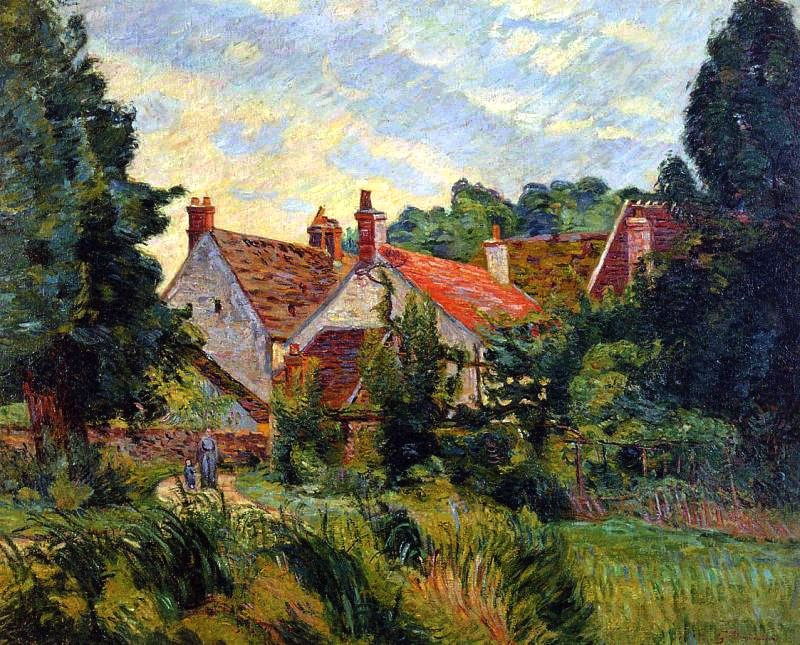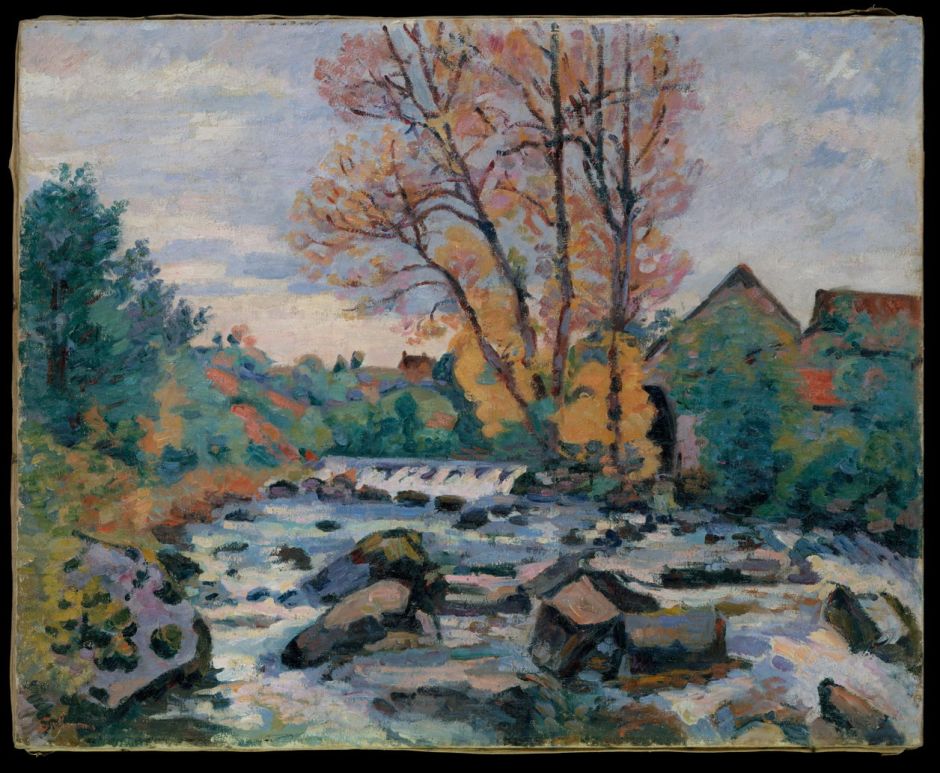The struggle for French Impressionist artists to gain recognition was hard and long, and for several including Paul Cézanne and Alfred Sisley extended after their death. Among those who still remain outside the canon is Jean-Baptiste Armand Guillaumin (1841-1927), who exhibited at the First Impressionist Exhibition and five of its successors, and painted in company with Pissarro and Cézanne.
Guillaumin’s story is strikingly similar to those of more famous artists. He first came to Paris at the age of sixteen to work in a shop, and took evening classes in drawing. By 1861, when he was twenty, he started to attend the Académie Suisse, then being run by the artist Etiènne Prosper Crébassol (1806–1883), where he became friends with fellow students Camille Pissarro and Paul Cézanne. He also learned to make engravings, although most of those now seem to have been lost.

The Seine (1867) is a typical early motif, a view of the River Seine in Paris, and shows unusually early coarse facture and bright colours, considering that it was painted two years before Monet’s celebrated views of La Grenouillère.

At the time that Pissarro, Monet, and Renoir were starting to explore the stark forms and subtle colours of snow scenes, Guillaumin painted Hollow in the Snow (1869).

Guillaumin was distinctive from early on in using very high chroma colours in his paintings, as shown here in his Landscape (c 1870).

This View of the Seine, Paris (1871) has clearly been worked on over a longer period in the studio, and appears unusually well finished and detailed.
To support his painting, Guillaumin worked for the Paris municipal services, at times digging ditches for three nights each week, and painting as much as he could in the daytime. He remained profoundly poor until late in life. In 1868, he left his service work, and painted blinds, as Renoir and Pissarro did at various times in their careers, but returned to municipal work in 1872. In that year, he painted near Pontoise, in company with Pissarro and Cézanne.
Guillaumin only showed three paintings at the First Impressionist Exhibition, of which one survives in the Musée d’Orsay:
- Evening
- Rainy Times
- Sunset at Ivry (below).

Probably his most famous painting today, Sunset at Ivry (1873) was bought by Dr Gachet, a great friend and patron to the Impressionists who cared for Vincent van Gogh during the final months of his life. It was loaned by Gachet to the First Impressionist Exhibition, and is one of forty-eight works of his now in the Musée d’Orsay. It must rank among the major Impressionist paintings of sunset.

Later that year, he painted The Seine at Charenton (formerly Daybreak) (1874), another of his urban riverside views.
Guillaumin again painted in company with Cézanne when they lived near to one another in 1875 and 1877. He went on to participate in five more of the Impressionist Exhibitions, in 1877 (the third), 1880 (fifth), 1881 (sixth), 1882 (seventh), and 1886 (eighth and last).

Pont Marie, Quai Sully (1878) returns to his very high chroma style, showing a row of horses and carts queued to move earth during embankment works in Paris.

His undated Notre Dame de Paris was probably painted during this mature period, and shows a familiar view.

La place Valhubert (also undated) is one of his finest riverside views. This location is further upstream from Notre Dame, by the Gare d’Austerlitz, and is seen in the warm light of dusk in winter.

His view of Épinay-sur-Orge from about 1884 marks another high point, in showing the rich colours of this village to the south of Paris, now swallowed up into the city’s sprawling suburbs. He painted several views around this area, most of which are comparable in their quality.
He became friends with Paul Signac in 1884, and for a while Guillaumin mentored Signac as he was starting to paint en plein air. As a result, Guillaumin joined Signac’s group, and exhibited with them in December 1884, with Seurat, Odilon Redon, and Schuffenecker. The following Spring, Guillaumin introduced Pissarro to Signac in his studio, leading to Signac introducing Pissarro to Georges Seurat, so setting up the friendships leading to Pissarro’s Neo-Impressionist period.
When Vincent van Gogh was living in Paris in 1886-88, he too became friends with Guillaumin, who at the time was living in the former studio of Daubigny.

River Scene (1890) is another of Guillaumin’s views of the bustling life alongside the River Seine in Paris, this time with a party of anglers, and two yachts under sail.

Guillaumin later brought his vibrant colours to the distant countryside dominated by the ancient volcano of Puy de Dôme, in the Massif Central, south central France. Plateau Bromont at Pontgibaud (Puy de Dôme) (1890) is one of the best of his paintings from that area.

Puy de Dôme Landscape (undated) is probably from the same period, but very different in its treatment of the local countryside.
Having endured much of his life in poverty, working while trying to find time to paint, in 1891 Guillaumin won sufficient in a lottery to finally provide him with financial security. However, by this time he had lost contact with his Impressionist friends, and it’s usually considered that his paintings had become weak and had lost their earlier attraction. His output increased considerably, though, and most of his surviving works are from this late period.

Painted around the time that he finally achieved financial security, his Self Portrait (c 1890-5) is almost as colourful as his landscapes.

Although many of his later paintings are weaker, some, including this Snow Landscape at Crozant, from around 1895, are still well-composed and accomplished. It suggests a reticence, even uncertainty, which might have contributed to his earlier lack of recognition.

He also explored new motifs, and his style continued to evolve, as shown in his Bouchardon Mill, Crozant (c 1898), which appears decidedly Post-Impressionist. Sadly such paintings were not ‘discovered’ by the likes of Roger Fry, nor were they promoted by dealers or galleries.
Late in his career, he finally achieved fame, with a succession of solo exhibitions in the galleries of major dealers between 1895-1908. Guillaumin seems to have stopped painting early in the twentieth century, and died in 1927.
His most recent catalogue raisonné, by Serret and Fabiani (1971), lists 847 of his paintings. Critical opinion of his work appears to be based mainly on his weaknesses rather than his strengths, and doesn’t do justice either to his importance in the Impressionist movement, or to his best paintings. His innovation, importance, and many great paintings should be celebrated alongside Pissarro, Monet, and Sisley.
References:
Wikipedia.
The First Impressionist Exhibition (in Italian), containing
the exhibition catalogue

